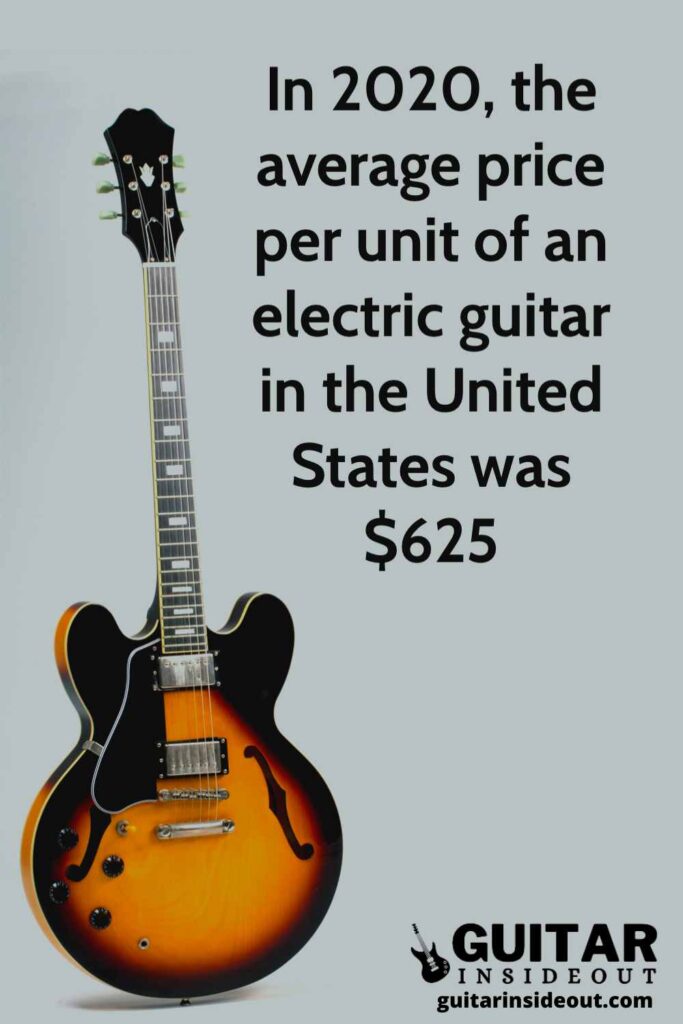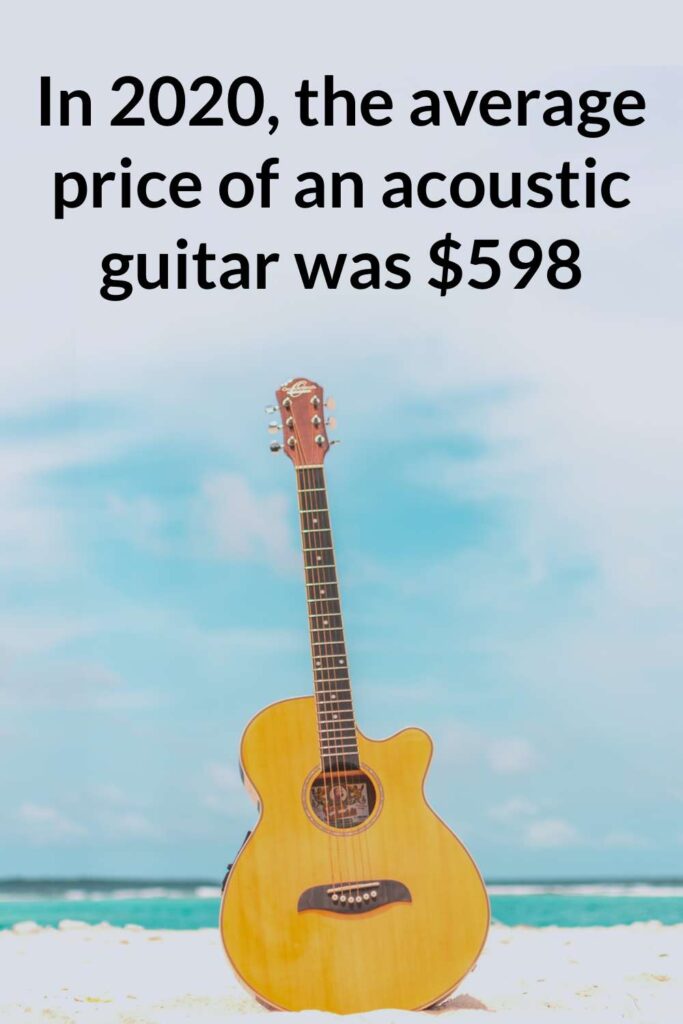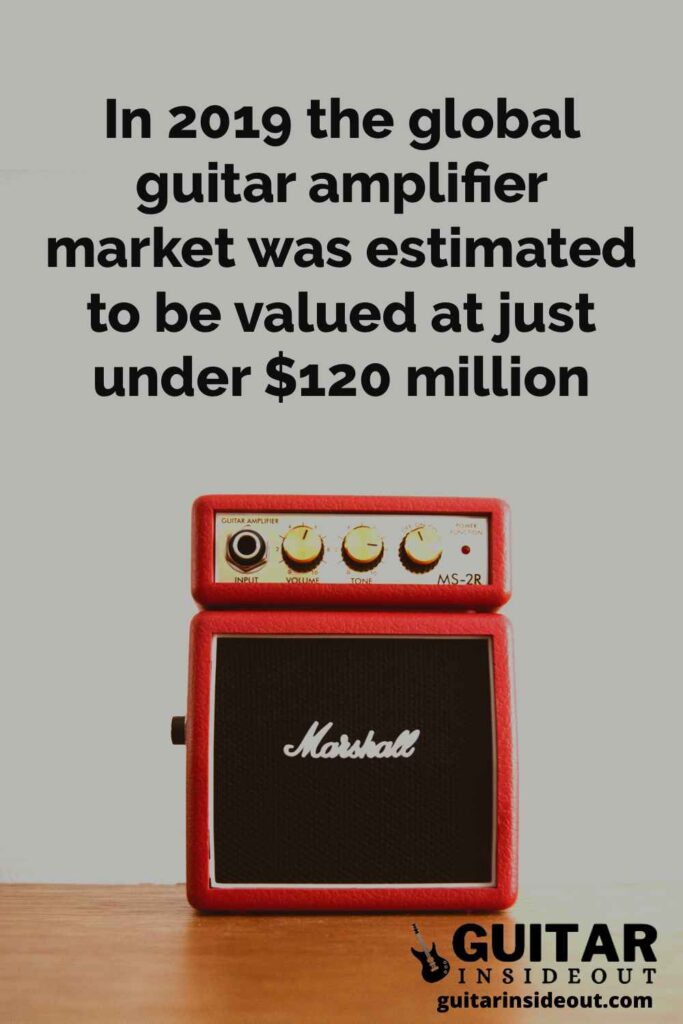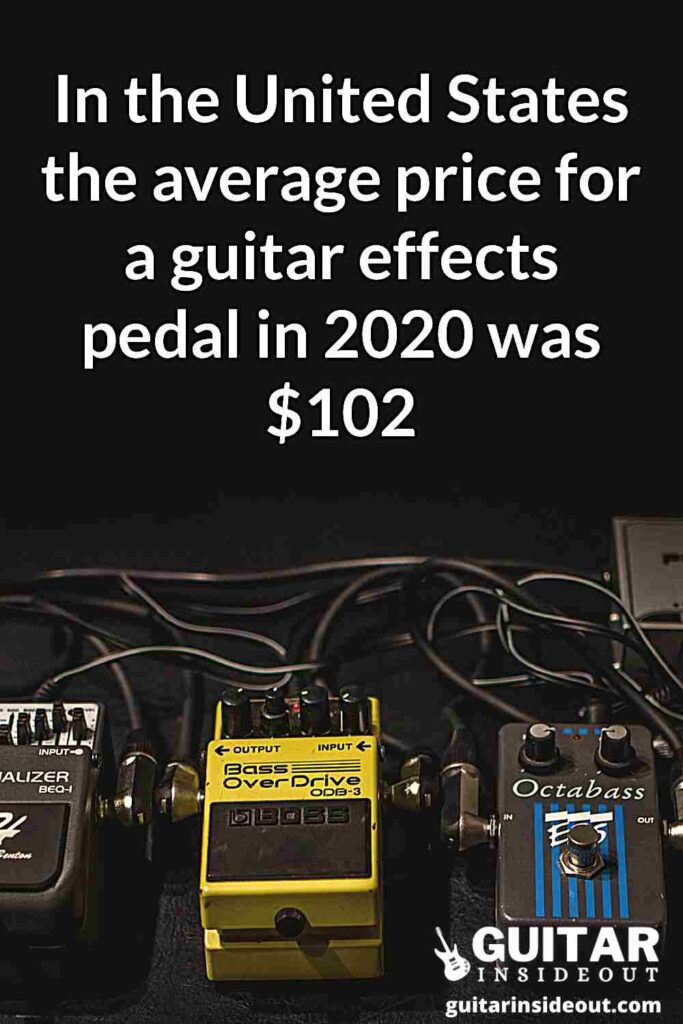Looking for the latest guitar industry statistics and trends? We’ve got you covered.
The last couple of years has been an fascinating one for the guitar industry. COVID has had a major impact on sales and interest in the guitar and with the continued and rising popularity of guitarists like Ed Sheeran and Taylor Swift you would assume the popularity of the guitar would be high.
These guitar and guitar industry statistics show the struggles and triumphs of the biggest brands as well as the changing demographics of who buys and plays the guitar.

Guitar Statistics
The following stats are about guitars in general and how well they’re selling, their price and the different types of guitars popularity.
#1. 2.6 million acoustic and electric guitars were sold in the United States in 2017, which is an increase from 300,000 in 2009 (Rolling Stone, 2018)
#2. By the end of 2019 there were 1.25 million electric guitar sold in the United States, up from the lowest figure of roughly 1 million in 2015 (NYTimes, 2020)
#3. However, numbers of electric guitars sold in the United States decreased by 9% in 2020 compared to 2019. 1.1 million electric guitars were sold in the United States in 2020 in comparison to 1.25 the million in 2019. (Statista, 2021)
#4. The average price of an electric guitar in the United States increased from 2005 to 2020. In 2020, the average price per unit of an electric guitar in the United States was $625. (Statista, 2021)

#5. The average price of an acoustic guitar in the United States increased from 2005 to 2020. In 2020, the average per unit price of an acoustic guitar was $598. (Statista, 2021)

#6. The average price of a guitar increased in the U.S. from 2005 to 2020. In 2020, the average price for a guitar was $609 (Statista, 2021)
#7. The most popular guitars being bought in 2020 were acoustic guitars, including semi-acoustic and electro-acoustic. (Musicstrive, 2021)
#8. The breakdown of each type of guitar sold in the United States, based on revenue, are as follows: 48% electric guitars, 33.2% semi-acoustic guitars and 18.6% acoustic guitars. (Musicstrive, 2021)
#9. Fender found that 50% of the guitars bought each year are by first time players and that 90% of them give up playing or learning within the first year. (Rolling Stone, 2018)
#10. The 10% that continue to play though will spend up to $10,000 over their life on guitars, amplifiers and accessories. (Rolling Stone, 2018)
#11. There was an increase of more than 50% of Google searches in 2020 compared to 2019 that contained the words ‘acoustic guitar’. (Musicstrive, 2021)
#12. The most popular guitar finish is black (Reverb, 2019)
Guitar Sales Statistics
These statistics look at the sales of guitars, the industry value overall and just how well they’re doing.
#13. Fretted instruments sales grew 7.3% to $1.9 billion in 2018 (Music Trades data. Reuters, 2018)
#14. The fretted instrument industry grew to over $8 billion in 2019 (Music Trades data. CNBC, 2020)
#15. In 2020 it reached $9.2 billion, an increase of 15% over a single year. (Musicstrive, 2021)
#16. $1.67 billion worth of fretted instruments (including electric, acoustic and bass guitars, and mandolins and banjos) were sold in the United States in 2020, an increase of 6.4% from 2019. (Musicthrive, 2021)
#17. There has been consecutive growth of guitar manufacturing over the last five years, with a projected increase through 2022 and beyond (IBISWorld data. Rolling Stone, 2018)
#18. Whilst the manufacturing of guitars may be rising guitar retailers are struggling, with online stores squeezing them out. (IBISWorld data. Rolling Stone, 2018)
#19. However, in 2020 the number of guitars sold in the United States fell to 2.74 million units from 2.8 million in 2019. This is a significant drop from the peak in 2005 of 3.3 million units, although both 2019 and 2020 were above average for the past decade. (Statista, 2021)
#20. Reverb.com sold between $400m and $500m worth of guitars in 2018, most of them used/second hand. (Guardian, 2018)
#21. During 2019 Fender’s sales of guitars rose by 17%, going from $600 million to a predicted increase of over $700 million in 2020. (CNBC, 2020)
#22. Fenders workforce of around 2000 employees all took pay cuts of up to 50% in 2019. (CNBC, 2020)
#23. In 2009 wholesale sales of guitars in the United States market was about $550 million. By 2020 that wholesale value had reached a high of $1.1 billion. (Statista, 2021)
#24. The sales of guitars increased between 2019 to 2020 by 15%. (Musicstrive, 2021)
#25. In 2020 most guitars sold were priced between $200 – $1000. (Musicstrive, 2021)
#26. During 2020 Fender guitars priced under $500 increased by 92%. (Musicstrive, 2021)
#27. Fender had estimated that 50% of its product are now being bought online. (Rolling Stone, 2018)
#28. PRS made between $42 million and $45 million in 2017 according to Paul Reed Smith. (Washington Post, 2017)
#29. In 2020 PRS’s revenue was $75.5 million, a 12% increase on 2019. (Musicstrive, 2021)
#30. Taylor guitars were the 15th largest supplier of guitars in 2020 and hit orders of 900 a day at one point. (Musicstrive, 2021)
#31. In 2009, during her financial crisis, guitar sales hit an all time low of $821 million in the United States. (Musicstrive, 2021)
#32. The Fender Player Telecaster was the top selling guitar in 2021 on Reverb.com. (Reverb, 2021)

#33. The Gretsch G9500 Jim Dandy was the best selling acoustic guitar in 2021 on Reverb.com. (Reverb, 2021)
#34. The Fender Player Precision bass was the top selling bass guitar in 2021 on Reverb.com. (Reverb, 2021)
Guitar Retail Statistics
There are some huge guitar retailers and these stats look at how they’ve been getting on over the last few years.
#35. In 2020 Sweetwater achieved more than $1 billion in revenue for the first time ever. This was due to a 50% increase in buyers with sales of over $1.5 million. (Musicstrive, 2021)
#36. Throughout 2020 Sweetwater were selling around 1000 guitars every day and were shipping out between 15,000 to 20,000 orders per day. (Musicstrive, 2021)
#37. Sweetwater saw a 50% – 100% growth year on year of most guitar brands, both electric and acoustic and at all prices. (CNBC, 2020)
#38. Guitar Center was forced to close 293 of its 296 retail showrooms in March and April 2020 because of the coronavirus pandemic. (nytimes, 2020)
#39. Despite these closures Guitar Center saw triple digit growth in online sales of the biggest guitar brands. (nytimes, 2020)
#40. Unfortunately Guitar Center’s debts had reached $1.3 billion by November 2020 and they had to file for Chapter 11 bankruptcy. (npr.org, 2021)
#41. Yet Guitar Center sales from 2021 are projected to reach a record $2.5 billion. With next years exceeding even that. Avclub, 2021)
#42. In the UK Gear4music saw guitar sales make up almost $30 million in 2020, which was an 80% increase from 2019. Whereas International sales made up over $22 million revenue in 2020. (Musicstrive, 2021)
#43. Lee Anderton of UK online retailer Anderton’s said that during the second half of 2020 they could only supply 50% of the demand for guitars. (Musicstrive, 2021)
#44. Imports of guitars have dropped 23% for acoustic guitars and 44% for electric guitars because of factory closures and shipping port bottlenecks in Asia. (Music Trades. Nytimes, 2020)
#45. The number of people employed in the guitar manufacturing sector peaked in 2014 at 3,933. By 2020 it had dropped to 3,797, and is forecast to decline even further in 2021. (Statista, 2021)

Guitar Demographic Statistics
The following stats focus on the demographics of who buys and plays guitars and how it has changed over time.
#46. In 1986 the guitar market was 95% male. By 2018 it was still at 85%. (Rolling Stone 2018)
#47. However, a consumer survey across North America in 2015 by Fender found that 50% of new guitarists were women (Rolling Stone 2018)
#48. About half of new buyers of Fender guitars are now women, and they are predominantly buying them online. (Yahoo, 2019)

#49. Fender’s Play App found approximately 45% of new guitarists were female in 2020, a 15% increase on those taking up guitar in 2019. (Musicstrive)
#50. In 2020 20% of those who registered with the Fender Play app were under 24 and 70% were over the age of 45. (Musicstrive, 2021)
#51. 46% of sales of guitars in 2020-2021 were in the Asia-Pacific region. (Musicstrive, 2021)
Learning Guitar Statistics
Tuition for the guitar is an important part of playing and as there are so many options for guitarists – apps, courses, teachers etc. – these stats look at this aspect of it.
#52. Of those who begin learning guitar for the first time 90% give it up within the first year. (CNBC, 2020)

#53. Those who stick with it buy several more guitars though and have a lifetime value of $10,000 to Fender. (CNBC, 2020)
#54. The guitar tuition app Fender Play had an increase of users from 150,000 to 930,000 between March and June 2020 thanks to a 3 month promotional giveaway. (Nytimes, 2020)
#55. 70% of the new Fender Play users in 2020 were under 45 and almost 20% were under 24. Female users made up 45% of these newcomers which is a 15% increase on the 30% that made up the user base prior to the pandemic. (Nytimes, 2020)
#56. The Gibson App saw 50,000 downloads to Android devices during 2020. (Musicstrive, 2021)
#57. In 2020 the Yousician app had 80% more subscribers than 2019 and 5.5 million new users. (Musicstrive, 2021)
Guitar Amplifier Statistics
If you’re playing the electric guitar then an amplifier is a necessity. The following statistics look at the amp market.
#58. In 2019 the global guitar amplifier market was estimated to be valued at just under $120 million. (Marketwatch, 2021)

#59. Fender Mustang amps are the biggest selling digital amps in the world. (Quartz, 2019)
#60. The Fender Mustang Micro was the best selling amplifier in 2021 on Reverb.com (Guitar World, 2021)
#61. The Fender Blues Junior was the top selling amp of 2017, 2018 and 2019 on Reverb.com (Reverb, 2021)
Guitar Pedal Statistics
Guitars pedals may be seen as an accessory but they are a huge market on their own. These stats show just how big and important guitar pedals are to musicians.
#62. 1.2 million guitar effects pedals were sold in the United States in 2020, this is down on 1.35 million that were sold in 2019. (Statista, 2021)
#63. This is a fall of 7% from 2020 to 2019 of the number of unit sales of guitar effects pedals in the United States. (Statista, 2021)
#64. In the United States the average price for a guitar effects pedal in 2020 was $102. This is an increasing trend from 2005 to 2020. (Statista, 2021)

#65. The effects pedal and processor market is expected to grow from $312 million in 2020 to $409 million by 2026. (Market watch, 2021)
#66. The Keeley Compressor Plus was the best selling pedal of 2021 on Reverb.com. (MusicRadar, 2021)
#67. The top selling brand of pedal on Reverb.com in 2020 was Boss. (Guitar.com, 2020)
Fender Statistics
Fender are arguably the biggest brand in the guitar world. Let’s look at their business and see the stats.
#68. In 2018 Fender made $560 million in global revenue. (Yahoo, 2019)
#69. This is an increase from revenue of $500 million Fender made in 2017. (Musicradar 2018)
#70. In 2018 Fender had less $100 million in debt. (Rolling stone, 2018)
#71. In 2020 Fender sold more guitars than in any other year of their history. (nytimes, 2020)

#72. Fender made $700 million in revenue in 2020, a 17% increase on 2019. (Musicstrive, 2021)
Gibson Statistics
Right up there with Fender are Gibson. They’ve had a rollercoaster ride recently so these stats make for interesting reading.
#73. Gibson was bought for just $5 million in 1985. (Tennessean, 2020)
#74. According to Gibson’s bankruptcy filing the company’s electric guitar sales increased by 10% between 2017 and 2018. (Rolling Stone, 2018)
#75. Gibson produced around 380 guitars a day in its Nashville plant in 2020. (Tennessean, 2020)
#76. Gibson employs about 350-400 workers in its factory and 120 more in the custom shop. (Tennessean, 2020)
#77. Gibson sells 170,000 guitars every year over 80 countries. (Rolling Stone, 2018)
#78. Gibsons debt in 2018 was $520 million. (Musicradar, 2018)
#79. Gibson’s revenue fell from $2.1 billion in 2015 to $1.7 billion in 2017. (Music Trades. Washington Post, 2017)
#80. Gibson profit margin in 2010 was 12.9% but by 2015 that profit margin had fallen to 4%. (Tennessean, 2020)
#81. Gibson has 22% market share of electric guitars and 40% for guitars of more than $2,000. (Tennessean, 2020)
Guitar Stats
The music and guitar industry moves so quickly it can be hard to keep up with the biggest trends in the world of guitars.
But reading up on the latest stats of the entire guitar industry is important to see where the changes are and how successful it currently is.
Andy
thanks so much for your work. I am currently involved in a venture directed at Guitar Players. Do you happen to have any demographics dealing with players ?
thank you
Mark
Hi Mark,
Unfortunately I don’t have anything about demographics. As far as I’m aware that sort of data either doesn’t exist or isn’t available. Sorry.
Just wondering— Around 1965, there were 1352 guitar pickers in Nashville. Do you have the number for 2023?
I don’t I’m afraid. I did hear that they can pick more notes than the number of ants on a Tennessee ant hill… maybe that will help?
That is a most excellent question, surely some one knows!